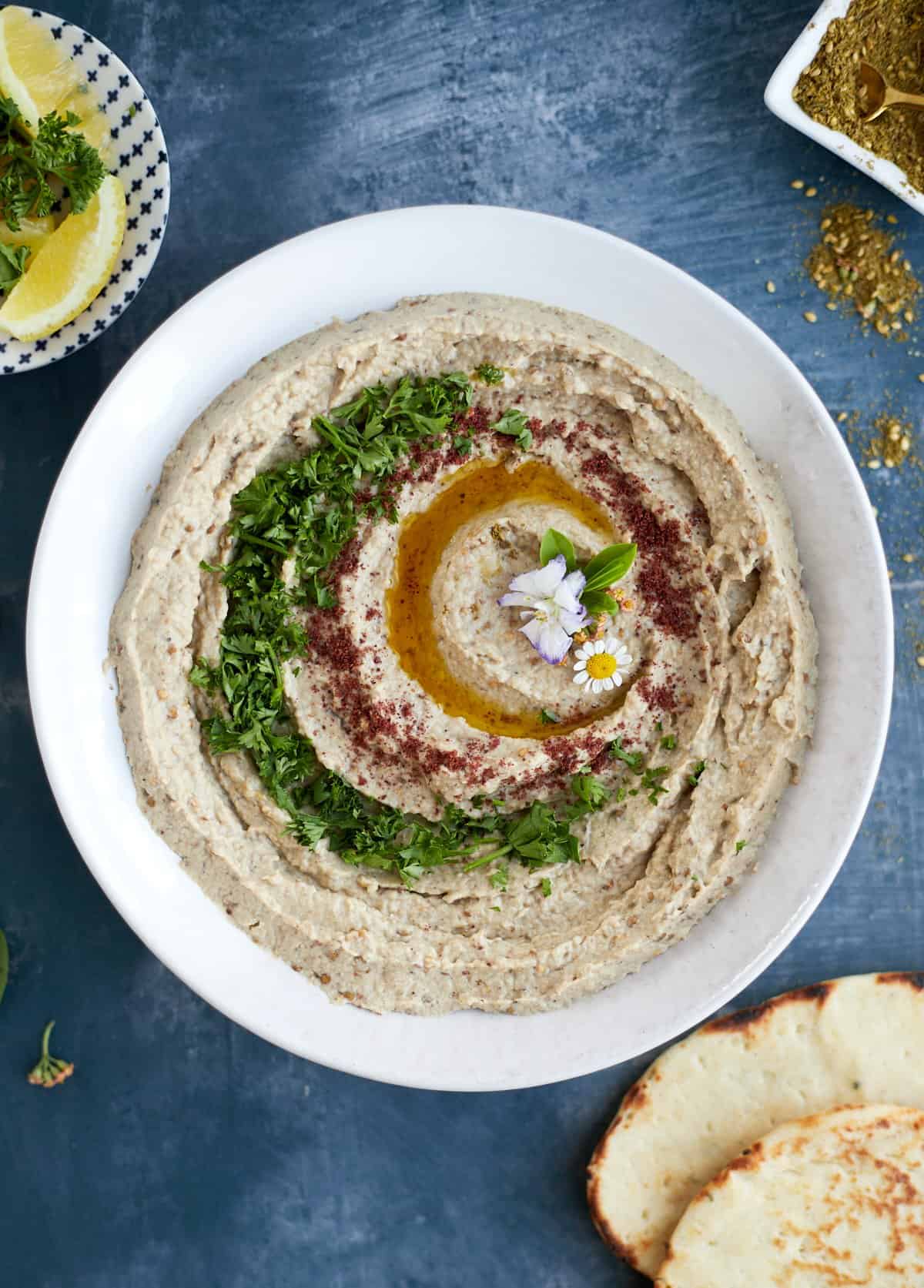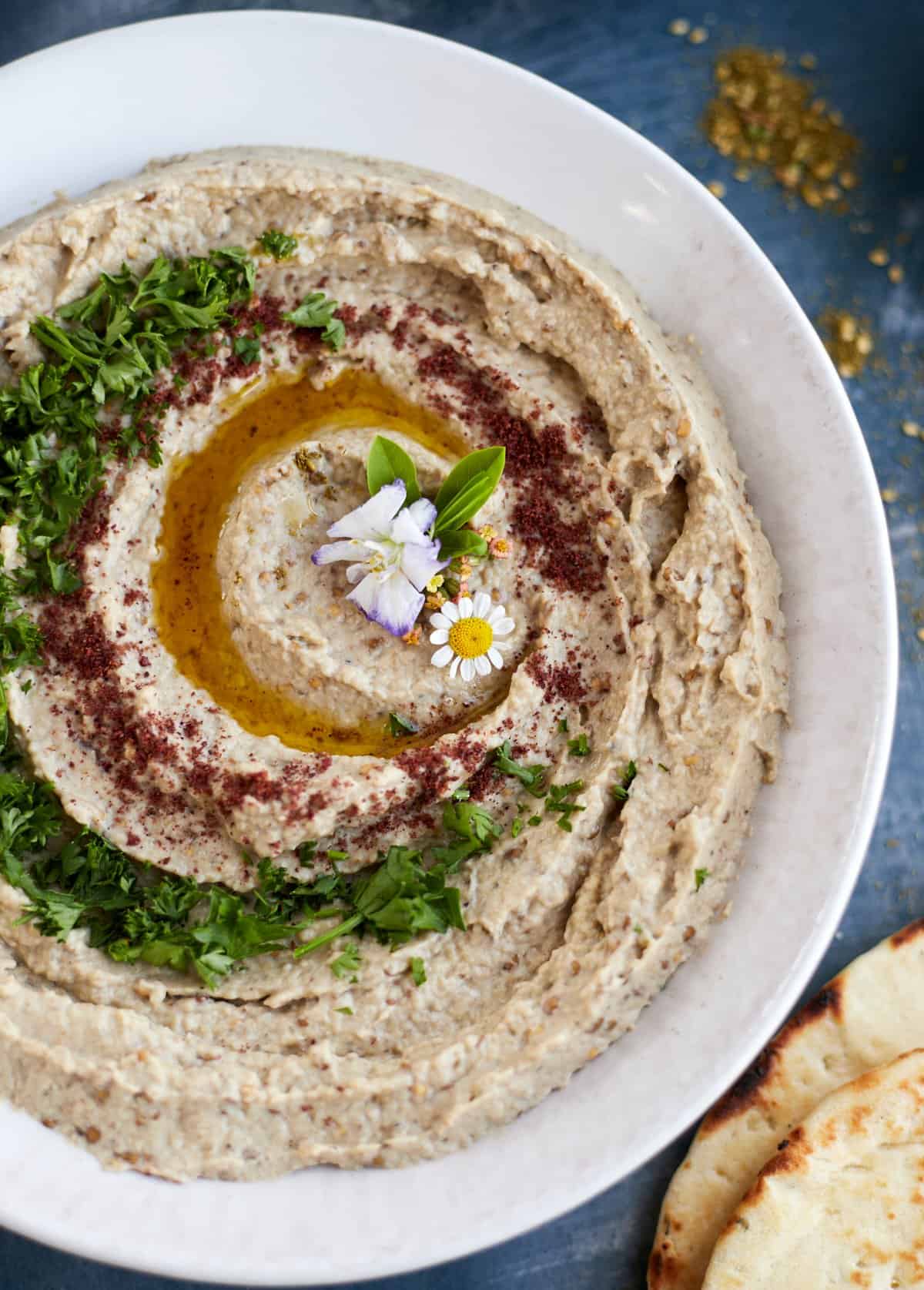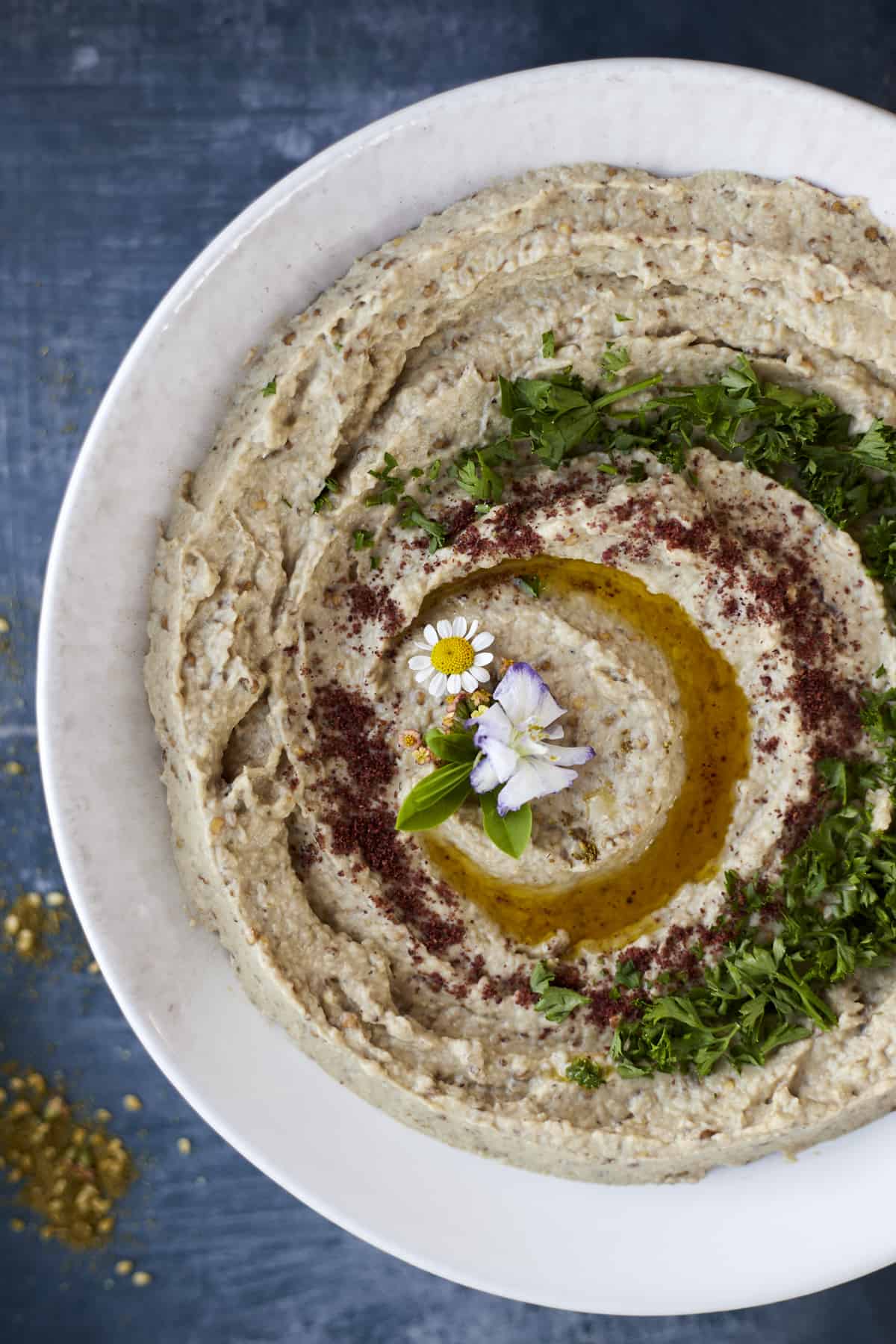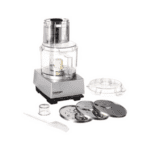Get ready to tantalize your taste buds with one of our all-time favorite recipes — Baba Ganoush! Imagine smoky roasted eggplant, creamy tahini, fragrant garlic, and a squeeze of fresh lemon juice all coming together in perfect harmony.
The result? A dip that’s as flavorful as it is versatile. This Middle Eastern masterpiece is earthy yet light, with a hint of citrus that will leave you craving more.
Spread it on pita bread, dip your veggies in it, or use it as a delicious topping for grilled meats — it’s sure to be a hit no matter how you serve it. We love it so much that it’s become a regular in our rotation, and we’re confident your whole family is going to love it too.

What is baba ganoush?
Baba ganoush is a delicious staple in Mediterranean cuisine. It can be used as a dip or a spread and is made primarily from eggplants and yogurt.
The recipe for baba ganoush is first seen in the Levant region around the 1500s. This region is in the heart of the modern Mediterranean coast, east of Italy.
Eggplants grow very easily in the climates near that region, which is why they are very common in Mediterranean cuisine. In fact, Egypt and India were the primary exporters of eggplants for a long stretch of history.
Over the years, baba ganoush staked its claim as a traditional part of Mediterranean food culture. And as baba ganoush lovers, we are very happy about that!
When are eggplants in season?
Eggplants are a hearty plant in the nightshade family.
Fun fact: tomatoes, white potatoes, chili peppers, bell peppers, okra, and gooseberries are also a part of the nightshade family.
Because of their heartiness, eggplants can grow in most climates all year round. Eggplants can be harvested through the cooler months as long as there is a warm, sunny summer to spark a strong growth season.
If you’re growing eggplants in your garden, you may notice that after the summer weather cools down, you may only be able to harvest one or two eggplants during the winter season. This is completely normal as the plant goes dormant in order to preserve its stems and roots for the next round of warm weather.
Eggplants will be the most flavorful over the summer, but the beauty of this star ingredient is that you can buy them and make this recipe at any point in the year!
Is Baba ganoush good for you?
One of the best parts about baba ganoush is that it’s healthy.. The primary ingredient is eggplant, which is as nutritious as it is delicious.
Eggplants are packed with vitamins and minerals, such as vitamin K and potassium. Eggplants also have a low sugar content, which makes them naturally low in calories and carbohydrates. And they are high in fiber!
While the roasted eggplants do contribute to the creaminess of this dish, the yogurt really helps get that classic baba ganoush texture. Compared to other dairy products in savory cuisine, yogurt clocks in at one of the healthiest.
Unsweetened yogurt is particularly good for you! It has high amounts of protein, calcium, and magnesium. Yogurt is also an incredible source of probiotics, which can help with gut health!
How to garnish baba ganoush
Our recipe calls for olive oil, parsley, and sumac as garnish. The reason we love garnishing with sumac, parsley, and olive oil is because of the flavor balance.
Sumac is a spice that is native to Iran but now grows throughout the Mediterranean coast. It was named for its characteristic red color and has a savory flavor with citrus undertones.
Parsley, which is also native to the Mediterranean region is more peppery in taste. The bite from the parsley and acidity from the sumac combined with olive oil is pure bliss on a plate!
But the great part about this recipe is that you can finish it to your own taste preference.
Dill is an herb commonly paired with eggplant dishes, as it has an earthy flavor profile. You can also squeeze on some lemon juice or zest a lemon over your baba ganoush for a hint of acidity. This dish also tastes incredible if topped with olive oil and Zaatar.
Basically, you can’t go wrong with garnish, and we highly recommend you experiment if you’re feeling adventurous!
How to make baba ganoush
- Fire roast your eggplants by placing the eggplant directly over an open flame on the stovetop. When the skin starts to blacken and bubble up, your eggplant is ready!
- Peel the eggplant and scoop into a food processor.
- Add yogurt, tahini, salt, pepper, and garlic to the food processor. Squeeze in lime juice and pulse together until combined.
- Remove from the food processor when the mixture is combined and a little bit chunky.
- Spread the baba ganoush onto a plate.
- Garnish with olive oil, sumac, and parsley. Dig in with your favorite crackers or pita, or spread onto a sandwich!
How to roast eggplant in the oven
- Preheat oven to 400 degrees F. Line a baking sheet with aluminum foil (helps for an easy clean-up)
- Poke holes in the eggplant with a fork or a tip of a sharp knife.
- Arrange them on the baking sheet.
- Flip around about halfway through baking. Roast until they burst and are tender, approximately 50-60 minutes.
- Let cool before peeling the skin and scooping out the flesh.
If you’re loving the flavors of Baba Ganoush and want to explore more Egyptian cuisine, you’re in for a treat! Here are some classic Egyptian recipes that are sure to delight your taste buds:
Phyllo Spinach Pie (Egyptian Goulash)
Hummus with Roasted Olives and Tomatoes

Fire Roasted Baba Ganoush
Ingredients
- 2 medium eggplants
- 1/4 cup greek yogurt
- 1/4 cup tahini
- 1 teaspoon kosher salt more or less to taste
- 1/2 teaspoon black pepper more or less to taste
- 2 cloves garlic
- juice of half a lime
Instructions
- Fire roast your eggplants by placing the eggplant directly over an open flame on the stove top. When the skin starts to blacken and bubble up, your eggplant is ready!2 medium eggplants
- Peel the eggplant and scoop into a food processor. Add yogurt, tahini, salt, pepper, and garlic to the food processor. Squeeze in lime juice and pulse together until combined.1/4 cup greek yogurt, 1/4 cup tahini, 1 teaspoon kosher salt, 1/2 teaspoon black pepper, 2 cloves garlic, juice of half a lime
- Remove from food processor when the mixture is combined and a little bit chunky.
- Spread the baba ganoush onto a plate.Garnish with olive oil, sumac, and parsley. Dig in with your favorite crackers or pita, or spread onto a sandwich!
Video
Equipment
Would you like to save this? 🔖
Nutrition
Nutrition information is automatically calculated, so should only be used as an approximation.














